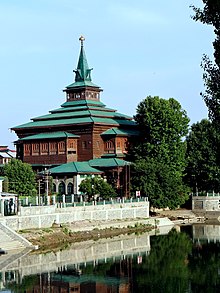Khanqah-e-Moula
| Khanqah-e-Mu'alla | |
|---|---|
خانقاہِ معلیٰ | |
 The Khanqah on the banks of Jhelum | |
| Religion | |
| Affiliation | Sunni Islam |
| District | Srinagar |
| Region | Kashmir Valley |
| Ecclesiastical or organizational status | Active |
| Status | Active |
| Location | |
| Location | Zaina Kadal, Srinagar |
| State | Jammu and Kashmir |
| Country | India |
| Geographic coordinates | 34°05′28″N 74°48′28″E / 34.091248°N 74.807771°E |
| Architecture | |
| Founder | Sultan Sikandar |
| Completed | 1395 CE, Rebuilt 1732 CE |
| Specifications | |
| Height (max) | 38m |
| Dome(s) | 1 (turret) |
| Minaret(s) | None |
Khanqah-e-Moula (Kashmiri: خانٛقاهِ معلىٰ), also known as Shah-e-Hamadan Masjid and Khanqah, is a mosque located in the Old City of Srinagar in Jammu and Kashmir, India. Situated on the right bank of the river Jhelum between the Fateh Kadal and Zaina Kadal bridges, it was built in 1395 CE, commissioned by Sultan Sikendar in memory of Mir Sayyid Ali Hamadani. It is held to be the first Khanqah—mosques associated with specific saints—in the Kashmir valley. It is one of the best examples of Kashmiri wooden architecture, and is decorated with papier mache.[1]
Construction
The mosque was commissioned by Sultan Sikandar Butshikan in 1395 CE in memory of the Islamic preacher Mir Sayyid Ali Hamadani, the central figure involved in the widespread conversion to Islam in Kashmir. Also known as Shah-e-Hamadan (the King of Hamadan), the preacher came to Kashmir from the city of Hamadan, Persia in the 14th century. He is credited for the spread of Islam in Kashmir. In 1480 AD, the shrine was destroyed in a fire. The then ruler, Sultan Hassan Shah, expanded its premises and rebuilt it. In 1731 CE, the Khanqah was again destroyed by fire and then rebuilt by Abdul Barkat Khan.
Background

Fire of 2017
On 15 November 2017, a fire broke out in the shrine which damaged the spire of the building. Fire tenders were brought on the scene and they managed to arrest the spread of the fire which prevented any further damage to the building.[2]
Restoration work was immediately started[3] and on 30 March 2018, a refurbished crown was successfully installed on the spire of the shrine.[4]
See also
References
- ^ "Asian Historical Architecture: A Photographic Survey". Asian Architecture.
- ^ "Khankah-e-Moula shrine damaged in Srinagar fire". 15 November 2017. Retrieved 5 May 2019.
- ^ "Latest News From Kashmir, Breaking News, Current Headlines, Kashmir News Online | Greater Kashmir". Retrieved 5 May 2019.
- ^ "Khankah-e-Maulla gets refurbished crown". 31 March 2018. Retrieved 5 May 2019.

